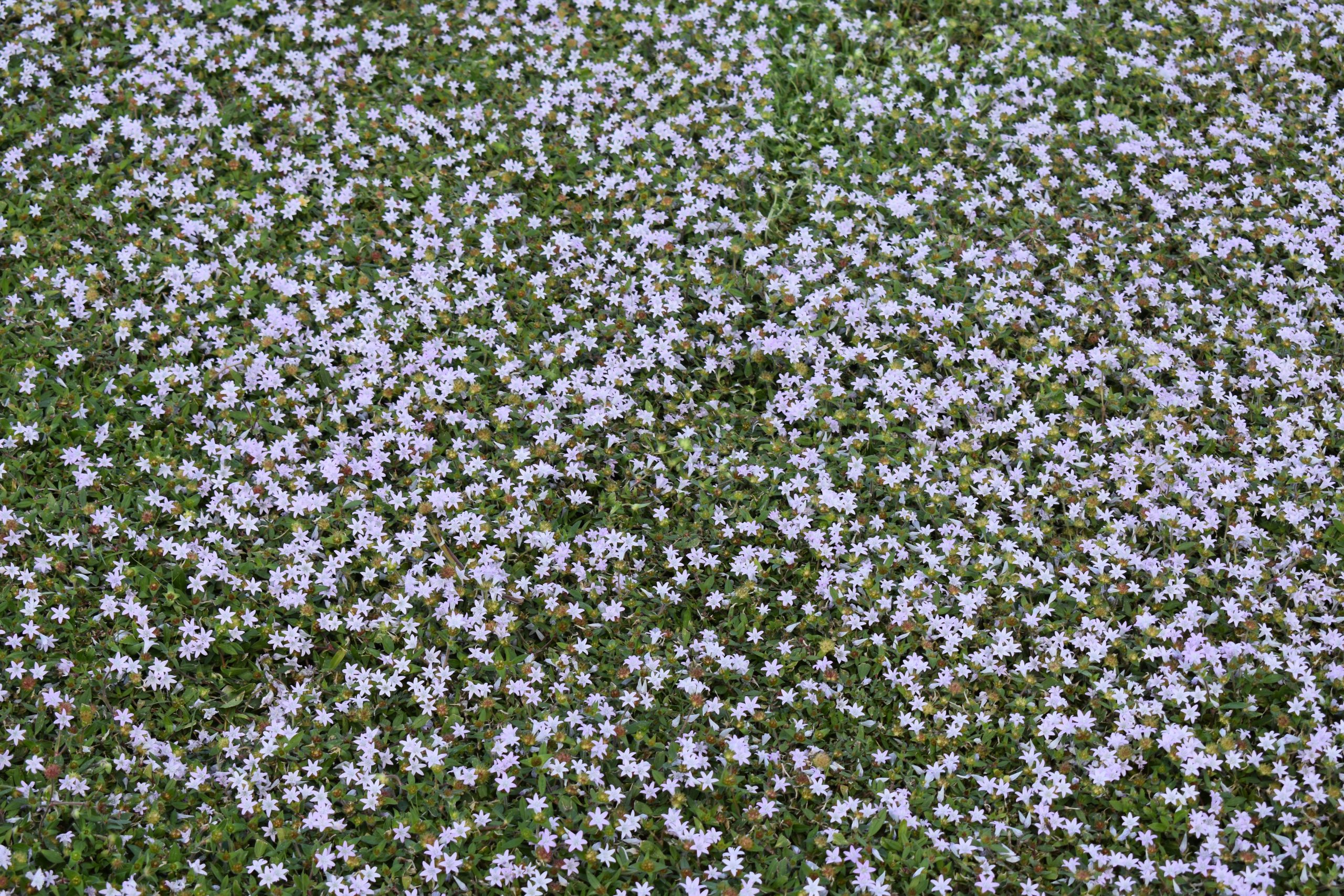“Florida Snow”
The weed now commonly called “Florida snow” is Richardia grandiflora, a creeping perennial that reproduces by seeds and stem fragments. There are three other Richardias, or pusleys, found in Florida, none of which are native to the state. “Florida Snow” becomes most evident in the fall and winter when flowering reaches its peak.



Why Weeds in Lawns?
Weed problems in a lawn indicate that the turf has been weakened by improper management practices or damage from pests. Proper management practices can eliminate most weed problems. Before thinking about herbicides, it is best to address the reasons why the turf is not at its best, which often includes mowing, irrigation, fertility, shade, and pest problems. If weeds are a persistent problem, herbicides labelled specifically for the turf being grown should be used. This recommendation is only for the control of “Florida Snow” and other pusleys in St. Augustine lawns.
Types of Herbicides
Two types of herbicides should be considered when trying to control these weeds, preemergence and postemergence. Preemergence herbicides are used to control weeds to prevent seed germination in the soil. Postemergence treatment is intended to control weeds that have already germinated. For many weeds, including “Florida Snow,” several applications of pre- and postemergence herbicides over one or more seasons may be necessary to control tough weeds.
Preemergence Control of “Florida Snow”
Timing is important when applying preemergence herbicides to control particular weeds. Preemergence control for pusley is typically done in late winter or early spring and before the grass begins to actively grow. Premergence products need to be activated either by irrigation or rainfall to work effectively. Homeowners can typically purchase preemergence herbicides that include dithiopyr (Preen Lawn Crabgrass Control) and pendimethalin (Scotts® WeedEx™ Prevent with Halts®) as the active ingredient at big-box stores in small quantities.
Postemergence Control of “Florida Snow”
Application is most effective when weeds are young. Fully developed pusleys may be tough to control because of their deep tap roots. Several applications may be necessary to do the job. In St. Augustine lawns, postemergence options to control pusleys are limited. A ‘weed-n-feed’ granular product is one option. However, ‘weed-n-feed’ is generally discouraged for use by homeowners. The fertilizer to herbicide ratio may be incorrect for particular situations resulting in unsuccessful control of pusleys and other weeds. There is also the risk that the herbicide contained in ‘weed-n-feed’ products may be applied incorrectly resulting in unintended damage to the lawn.
Liquid atrazine is used as a postemergence control of broadleaf weeds. When used at temperatures above 85ºF-90ºF, atrazine may damage St. Augustine and other lawns. Fall and winter are usually the best times for atrazine applications.
In addition to atrazine, there is a pre-mix of penoxsulam + sulfentrazone + 2,4-D + dicamba (Image Southern Lawn Weed Killer for St. Augustinegrass and Centipedegrass) which has activity against broadleaf weeds including some pusleys. It is designed for safety to St. Augustinegrass and is available for homeowners. Also, there is a sulfentrazone-based product (Ortho® Nutsedge Killer For Lawns) which is labeled for the control of Florida pusley.
Herbicides containing metsulfuron are also used as a postemergence treatment for pusleys and other broadleaf weeds. Be aware that herbicides containing metsulfuron, dicamba, and atrazine can cause injury to non-target ornamental plants when applied over their root zones that often extend into turfgrass areas.
Additional Precautions
Homeowners are discouraged from using professional-grade herbicides without proper training and equipment calibration. It is important to carefully read and follow label instructions of all herbicides prior to application. The risk that safe products improperly applied may cause damage to desired grass or other plants should be considered, especially when growing conditions or turf health is not optimal. Application to a small test area where injury to turf may be tolerated prior to the application to the entire lawn is always a good idea.
The mention of any product is not an intention of endorsement. Consult with your local extension agent for the latest in herbicide and other pesticide recommendations.
Thanks to Dr. Pawel Petelewicz, assistant professor, turf weed science, for his guidance and contributions to this post.
Check out the Instagram video on “Florida Snow” posted on 12/8/23 at lee_ufifas.
All pictures taken by Stephen H. Brown.
Resources
Trenholm L.E., M. Schiavon, B. Unruh, T. Shadow, and K. Kenworthy. Revised 2021. “St. Augustinegrass for Florida Lawns.” ENH5. UF/IFAS University of Florida.
Anderson E., P. Petlewicz, and C. Marble. 2021. “Biology and Management of Pusley (Richardia L.) in Turfgrass and Landscape Beds.” ENH1346. UF/IFAS University of Florida.
 3
3
